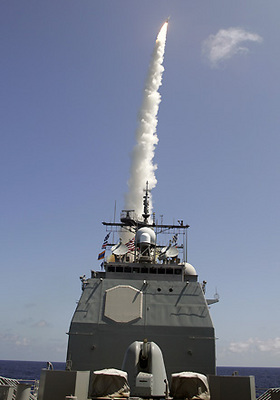
|
| ©US Navy |
| A missile fired from the USS Lake Erie will attempt to shoot down the crippled satellite |
A US attempt to shoot down a damaged spy satellite would probably be delayed because of poor weather, Pentagon officials say.
Weather forecasts in the Pacific, where a US warship is stationed for the mission, indicated that seas would not be calm enough for the ship to fire a missile at the satellite and destroy it, the officials said.
US military officials say the satellite is carrying highly toxic hydrazine rocket fuel that could be dangerous if it fell on a populated area.
But the decision to shoot it down has been criticised by China and Russia who say the move is a cover for testing anti-satellite weaponry.
The Pentagon has to act before February 29, when the dead satellite is projected to re-enter the Earth's atmosphere.
On Wednesday, the space shuttle Atlantis landed in Florida, clearing the way for
the military operation to proceed.
The Pentagon had been waiting for the shuttle to land to avoid contact with flying debris as the satellite returned to Earth.
Atlantis returned after completing a mission to deliver Europe's first permanent space laboratory to the International Space Station.
Blazing descent
The USS Lake Erie is stationed in the western Pacific in waters off the US state of Hawaii and awaiting the order to shoot down the missile with a specially modified missile.
Officials will know within minutes of the missile launch whether the
missile has hit the satellite, but it will take a day or two to know whether
the fuel tank has been destroyed, officials said.
The operation is most likely to take place during daylight hours and all ships and air traffic have been warned to stay away from the area ahead of the operation, officials say.
"We'll make decisions each day as to whether we're going to proceed or not," a Pentagon official was quoted by Reuters news agency as saying.
Left alone, about half of the 5,000-pound spacecraft was expected to
survive its blazing descent through the atmosphere and would scatter debris over several hundred miles.
Rogue satellite
Satellite code name USA-193 launched in December 2006 on a Delta II rocket from Vandenberg Air Force Base in California
Top secret military reconnaissance mission - otherwise known as a spy satellite
Controllers lost contact with satellite hours after it entered orbit Carrying approximately 450 kg of toxic hydrazine rocket fuel
Satellite itself weighs about two tonnes and is about the size of a bus.
Health 'concerns'
George Bush, the US president, gave the order last week for the satellite to be shot down, saying the move was based on protecting human health.
The satellite is carrying about half a tonne of hydrazine, a toxic propellant that would have been used to reposition the satellite while in orbit.
The material can be fatal to humans in large doses.
However both China and Russia criticised the move, saying it could harm security in space.
A Chinese foreign ministry spokesman told reporters: "Relevant departments of China are closely watching the situation and working out preventive measures."
Last year, China was itself criticised by the US and several of its allies which accused Beijing of risking a space arms race after it used a ballistic missile to destroy one of its own obsolete weather satellites.
Russian anger
Russia's defence ministry has also said it fears the US plan is a veiled test of US anti-satellite capabilities and represents an "attempt to move the arms race into space".
The ministry said: "The decision to destroy the American satellite does not look harmless as they try to claim, especially at a time when the US has been evading negotiations on the limitation of an arms race in outer space."
Critics have also said the justification of health fears may be a cover for preventing highly-classified spy satellite technology from falling into foreign hands.
The missile carries a non-explosive "kinetic kill vehicle" - designed essentially to destroy the satellite by smashing into it.
The technique is similar to the system employed in US anti-missile shields.



Reader Comments
to our Newsletter